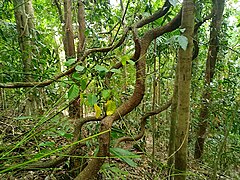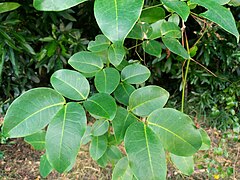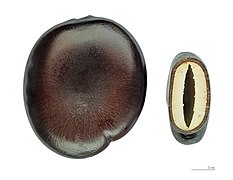
The paʻanga is the currency of Tonga. It is controlled by the National Reserve Bank of Tonga in Nukuʻalofa. The paʻanga is not convertible and is pegged to a basket of currencies comprising the Australian, New Zealand, and United States dollars and the Japanese yen. Tonga is the second smallest country in the world, by population, after the Seychelles to have its own currency and monetary policy.

Banksia petiolaris is a rare species of flowering plant in the family Proteaceae native to Western Australia, where it is found in sandy soils in the south coastal regions from Munglinup east to Israelite Bay. It was first described by Victorian state botanist Ferdinand von Mueller in 1864, and no subspecies are recognised. B. petiolaris is one of several closely related species that will all grow as prostrate shrubs, with horizontal stems and thick, leathery upright leaves. Those of this species can be viable for up to 13 years—the longest-lived of any flowering plant recorded. It bears yellow cylindrical flower spikes, known as inflorescences, up to 16 cm high in spring. As the spikes age, they turn grey and develop up to 20 woody seed pods, known as follicles, each.
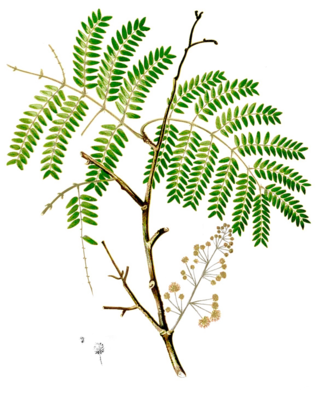
Senegalia rugata is a spiny climbing shrub native to China and tropical Asia, common in the warm plains of central and south India. It is renowned as a raw material for shampoo, and the leaves and young shoots are often eaten. Archaeobotanical evidence shows its use for hair care in the pre-Harrapan levels of Banawali, some 4500–4300 years ago.

Entada rheedii, commonly known as African dream herb or snuff box sea bean, and as the cacoon vine in Jamaica, is a large woody liana or climber of the Mimosa Family (Mimosaceae). The vine can grow as long as 120 m (390 ft). Their seeds have a thick and durable seed coat which allows them to survive lengthy periods of immersion in seawater.

Neolitsea dealbata, also known as white bolly gum, hairy-leaved bolly gum, or simply bolly gum, is a shrub or small tree in the laurel family Lauraceae which is native to New South Wales and Queensland in Australia.

Entada is a genus of flowering plants in the family Fabaceae, in the mimosoid clade of the subfamily Caesalpinioideae. It consists of some 30 species of trees, shrubs and tropical lianas. About 21 species are known from Africa, six from Asia, two from the American tropics and one with a pantropical distribution. They have compound leaves and produce exceptionally large seedpods of up to 1.5 metres (4.9 ft) long. Their seeds are buoyant and survive lengthy journeys via rivers and ocean currents, to eventually wash up on tropical beaches.

Entada gigas, commonly known as the monkey-ladder, sea bean, cœur de la mer or sea heart, is a species of flowering liana in the pea family, Fabaceae of the Mimosa subfamily, which is often raised to family rank (Mimosaceae). They are native to Central America, the Caribbean, northern South America, and Africa. It is notable for having the family's largest seedpods, which measure 12 cm (4.7 in) across and can reach 2 m (6.6 ft) in length. There have been reports of pods up to eight feet in length. This pod, like all legumes, is a single carpel, the largest carpel of any known plant. Inside the pods are ten to fifteen seeds, each of which have a diameter of 6 cm (2.4 in) and a thickness of 2 cm (0.79 in). The seeds contain a hollow cavity, which gives them buoyancy. After being washed by rain into rivers and then the ocean, the seeds of E. gigas drift long distances on ocean currents. Seed buoyancy and vitality lasts at least two years.

Guilandina bonduc, commonly known as grey nicker, nicker bean, fever nut or knicker nut, is a species of flowering plant in the senna tribe, Caesalpinieae, that has a pantropical distribution. It is a liana that reaches a length of 6 m (20 ft) or more and scrambles over other vegetation. The stems are covered in curved spines. Its 2 cm (0.8 in) grey seeds, known as nickernuts, are buoyant and durable enough to be dispersed by ocean currents.

Hicksbeachia pinnatifolia is a small tree in the family Proteaceae. This rare species is native to subtropical rainforest in New South Wales and Queensland in Australia. Common names include red bopple nut, monkey nut, red nut, beef nut, rose nut and ivory silky oak. The tree produces fleshy, red fruits during spring and summer. These contain edible seeds.

Mallotus philippensis is a plant in the spurge family. It is known as the kamala tree or red kamala or kumkum tree, due to the fruit covering, which produces a red dye. However, it must be distinguished from kamala meaning "lotus" in many Indian languages, an unrelated plant, flower, and sometimes metonymic spiritual or artistic concept. Mallotus philippensis has many other local names. This kamala often appears in rainforest margins. Or in disturbed areas free from fire, in moderate to high rainfall areas.
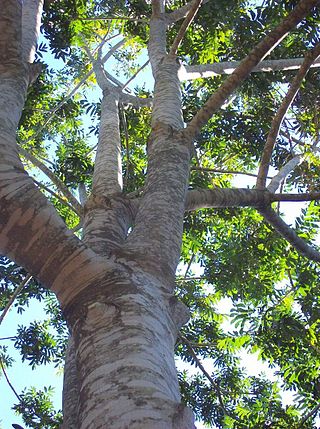
Didymocheton rufus is a rainforest tree in the family Meliaceae, found in eastern Australia. It occurs on a variety of different soils and rainforest types. From as far south as Bulahdelah, New South Wales to the McIlwraith Range in far north eastern Australia. The specific epithet rufus refers to the rusty red of the leaf, fruit and flower hairs of this species.
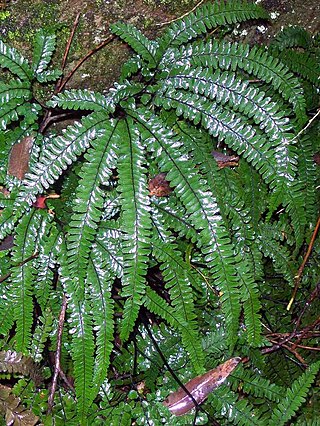
Adiantum hispidulum, commonly known as rough maidenhair fern or five-fingered jack, is a small fern in the family Pteridaceae of widespread distribution. It is found in Africa, Australia, Polynesia, Malesia, New Zealand and other Pacific Islands. Its fronds rise in clumps from rhizomes among rocks or in the soil in sheltered areas.
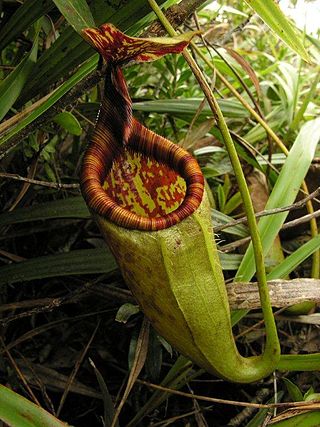
Nepenthes gantungensis is a tropical pitcher plant known from a single peak on the Philippine island of Palawan, where it grows at elevations of 1600–1784 m above sea level.

Goniocheton arborescens, commonly known in Australia as Mossman mahogany, is a small tree in the mahogany family Meliaceae. It is native to rainforests of Malesia, Papuasia, Queensland and nearby islands.

Petersianthus quadrialatus is an emergent tropical rainforest tree species in the Lecythidaceae family. In the Visayas region called kapullan, in the Samar and Leyte areas - magtalisai. It is an indigenous tree species in the southeastern Philippines and one of the largest tree species in the Philippines islands.

Acacia mollifolia, commonly known as the hairy silver wattle, velvet acacia and hoary silver wattle is a species of Acacia native to eastern Australia.

Acacia leucoclada, commonly known as the northern silver wattle, is a species of Acacia native to eastern Australia.

Entada burkei, commonly known as the elephant root or sumach bean, is a deciduous shrub or small tree in the mimosoid clade of legumes. It is native to southern Africa, in Mozambique, Zimbabwe, Botswana, and the Northern Provinces of South Africa. It grows on rocky slopes or ridges, in either woodland, grassland or scrubland. The species is named after the botanist Joseph Burke.

Mucuna gigantea, commonly known as burny bean, burney bean, velvet bean or sea bean is a species of liana from the legume family Fabaceae. Its natural range roughly follows the perimeter of the Indian Ocean and includes Africa, India, Malesia, New Guinea and northern Australia. Many parts of the plant - in particular the new growth, flowers and fruit - are covered in fine irritant hairs.

Mucuna urens is a species of large liana from the family Fabaceae. The plant is native to tropical Central and South America, and has been introduced into the Republic of the Congo. Common names include horse-eye bean and ox-eye bean.

